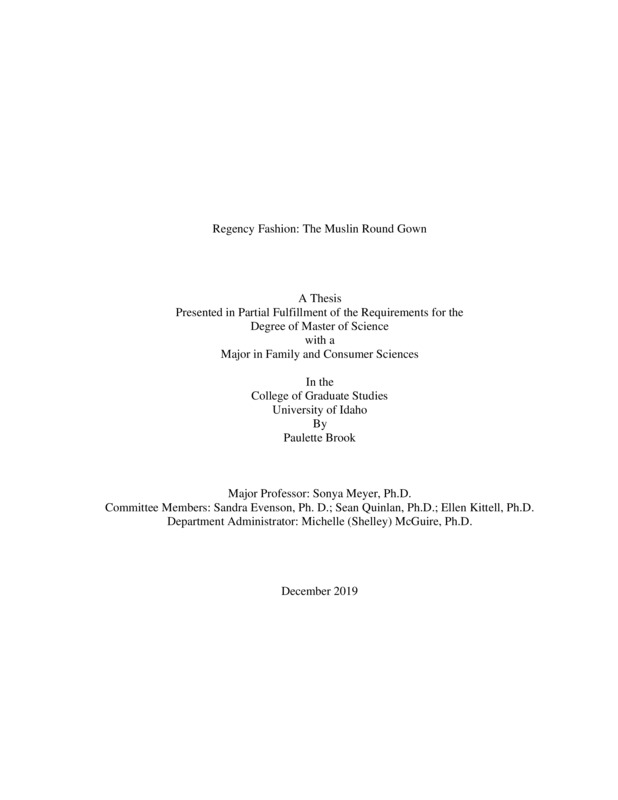Regency Fashion: The Muslin Round Gown
Brook, Eva Paulette. (2019-12). Regency Fashion: The Muslin Round Gown. Theses and Dissertations Collection, University of Idaho Library Digital Collections. https://www.lib.uidaho.edu/digital/etd/items/brook_idaho_0089n_11737.html
- Title:
- Regency Fashion: The Muslin Round Gown
- Author:
- Brook, Eva Paulette
- Date:
- 2019-12
- Embargo Remove Date:
- 2021-01-02
- Keywords:
- Fashion Georgian Muslin Regency Trade
- Program:
- Family and Consumer Sciences
- Subject Category:
- Home economics education; History
- Abstract:
-
ABSTRACT
Fashion mirrors culture. In the late Georgian and Regency Periods, the evolution of a particular gown reflected the political, social, economic, and religious attitudes and movements of the time. The white, round gown made from Indian muslin grew to popularity in the last decade of the 18th century. Originating in France then moving across the Channel to England, I demonstrated how changes in the round, muslin gown reflected socio-political events occurring during the period from 1799 to 1828. In the 1820s the fashion was declining and by 1830 gone from the world of dress in the nation and beyond.
Contemporary women’s journals of the era provided articles including images of current fashion. These sources offered primary information in a form from which data could be extracted and tabulated. Points were assigned to each garment based on the “Classification System for Types of Dress and their Properties” (Classification System) created by Mary Ellen Roach-Higgins and Joanne B. Eicher and the features suggested by Alden O’Brien; columnar shape, low neckline, high waistline, and white muslin fabric. For each image a zero per feature matching the criteria requisite to distinguish it a Regency gown was charted. For features such as attachments to enclosures indicated by Roach-Higgins and Eicher, one to three points were assigned. For example, if the skirt had a flounce it was given one point. More than one attachment increased the points for that skirt (enclosure for the lower body). The same method was applied to the bodice and sleeves as necessary. In viewing the data table created it was possible to see how and when the fashion was modified during the twenty-eight-year span of time. Consulting contemporary culture via historical accounts offered insight into what may have prompted a minimal or greater alteration in style.
The table illustrates how the specific features of the gown morphed throughout the years. The greatest alteration occurred in the shape of the gown, which declined by 84% from columnar to a bell-shaped form, then the waistline which dropped by 48% from a very high waist to one that rested at or very near the natural waistline. The neckline and fabric (muslin) declined by 42% and 24% respectively. The feature with the least percentage of adjustment was the color of the gowns at 6%.
Attachments to the enclosures signified the greatest change. Flounces on the skirts were the first to emerge followed by quilling and mancherons on the bodice. Each of these components increased over the period until there were multiple flounces, appliques, and puffings, on most gowns. As the attachments were added, the width of the skirt grew, the waistline dropped, the neckline rose, and the shoulders broadened. New fabrics and colors emerged also. The Regency gown of the early nineteenth century was gone by 1828.
- Description:
- masters, M.S., Family and Consumer Sciences -- University of Idaho - College of Graduate Studies, 2019-12
- Major Professor:
- Meyer, Sonya S
- Committee:
- Evenson, Sandra L; Quinlan, Sean ; Kittell, Ellen
- Defense Date:
- 2019-12
- Identifier:
- Brook_idaho_0089N_11737
- Type:
- Text
- Format Original:
- Format:
- application/pdf
- Rights:
- In Copyright - Educational Use Permitted. For more information, please contact University of Idaho Library Special Collections and Archives Department at libspec@uidaho.edu.
- Standardized Rights:
- http://rightsstatements.org/vocab/InC-EDU/1.0/

